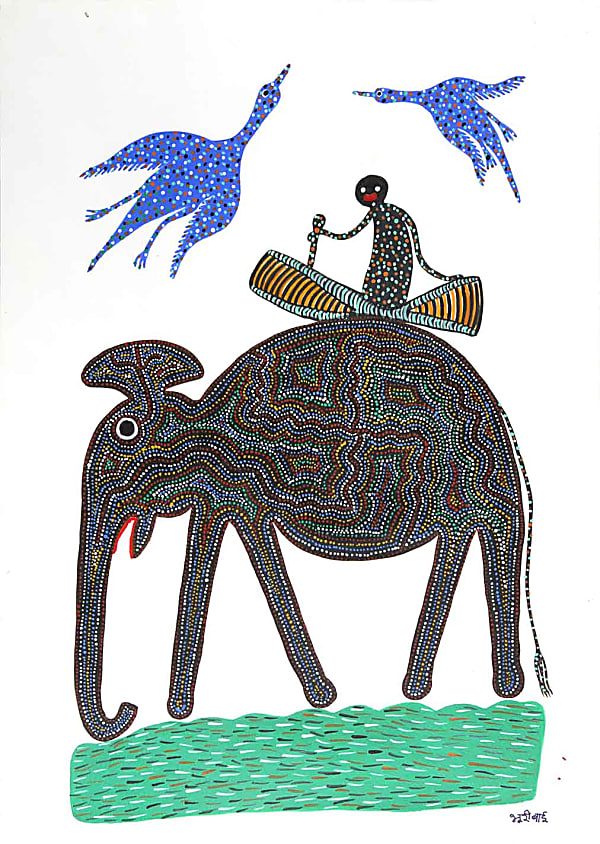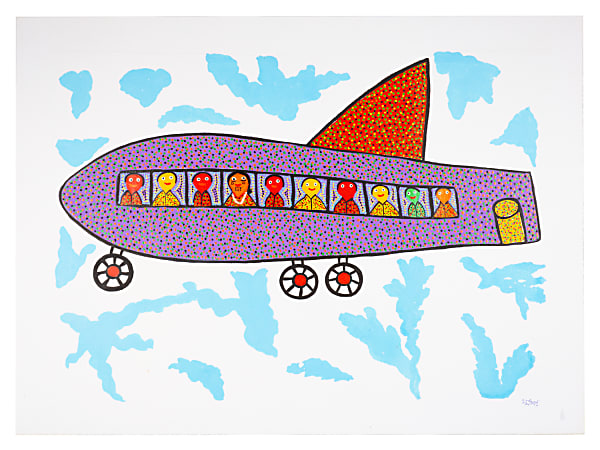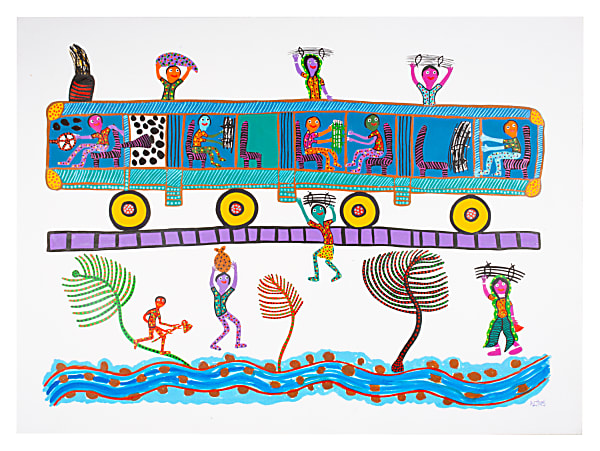Blogs
Mapping the Dots
Shonali Madapa
Bhuri Bai’s recent exhibition at MAP sheds light on her artistic journey and the transformation from a local indigenous artist who painted mud walls in her village, to a much lauded contemporary artist.
Bhuri Bai’s recent exhibition at MAP sheds light on her artistic journey and the transformation from a local indigenous artist who painted mud walls in her village, to a much lauded contemporary artist. Her early works exhibit the earthy, bright colours of the traditional Bhil palette – black, red, green and yellow, inspired by themes from everyday life and covered with an infill of uniform dots in several patterns, which stand out strikingly against the background.
The dots are the distinct identity of Bhil art and have multiple layers of symbolism. Inspired by the kernels of maize, which is the staple food and crop of the Bhils, the groups of dots in a Bhil painting represent a particular ancestor or deity. The interesting aspect here is that each artist composes the dots in distinctive patterns, encoding every artwork with a signature that is only visible to the trained eye.
As humans, creating patterns is intrinsic to us. Over millennia, our brains and senses have evolved largely to find patterns that have made survival and reproduction possible. It is the way we learn, and it is what makes the world interpretable to us.

Untitled, Bhuri Bai, c. 1980s, Poster colour on paper, MAP, Accession No.: PTG.0753
Bhuri Bai’s early work displays dots that are rough, irregular and loosely spaced, perhaps a direct consequence of using a neem stick or a twig as a brush. In her later works, we see sophisticated dot patterns creating a brilliant visual rhythm, drawing the eye into the subject with a dazzling array of colour and form. Over an interview, she recalled that it was after she was exposed to working with modern colours and brushes that her work underwent a stylistic change. The use of fine brushes and the variety of different colours available readily in a city has influenced the way she paints — an element that is mirrored in the intricate patterns that are characteristic of her later work.
Bhuri Bai’s paintings have progressed into tableaus that combine both rural and urban motifs, from specific places and moments in times, as well as depicting animals and plants in more naturalistic forms. When speaking to Bhuri Bai, her love for the village is apparent. She describes the wide open spaces, the trees, the animals and birds who shelter and live there. These are the visions that inspire her to replicate them in her work.

Untitled, Bhuri Bai, c. 1980s, Acrylic on handmade paper, MAP, Accession No.: PTG.0731
The multitude of experiences and the various strands of her journey through life, form the subject matter of her paintings. Her first overseas flight to the US results in a charming painting of an aeroplane. Similarly, an image of a train seeming to float above the river below is drawn from her childhood memories of traveling by train to the nearest town to sell firewood. The apparent lack of perspective is characteristic of more traditional forms of Indian painting, where two dimensional images are depicted rather than three dimensional ones.

Untitled, Bhuri Bai, 2018, Poster colour on paper, MAP, Accession No.: PTG.01811

Untitled, Bhuri Bai, 2018, Poster colour on paper, MAP, Accession No.: PTG.01800
Bhuri Bhai’s encounter with the artist Jagdish Swaminathan in 1980 at Bharat Bhavan in Bhopal, changed her life. When Swaminathan learnt that she had made drawings on the walls of her home as a child, he insisted she make a few paintings for him. Refusing to sit inside a room to paint, she asked to paint in the open. For five days, she sat at the stairs of a temple near the construction site and made her first paintings on a roll of brown packing paper with poster paints and paint brushes supplied by Swaminathan—materials she had never used before and was unfamiliar with. It took her a long time to learn how to mix the paint and work with a brush.
The first paintings she made used simple colours and depicted traditional tattoo motifs as well as scenes from village life. It was only later in the 1990’s that she began to experiment with the vibrant synthetic colours available in the city and included them in her palette.
Bhuri Bai has taught most of her family to paint in the traditional Bhil style and would like her legacy to endure through future generations. She feels this is the way to express her gratitude for her art, which has changed her life in numerous ways. Her journey from being a poor manual labourer to an artist, whose work is exhibited and lauded around the world is solely because of her art.
Shonali Madapa runs a design studio, Lumos Design, in Mysore, India. She collates and documents cultural patterns and ways of life, and manages to find beauty in the mundane.








